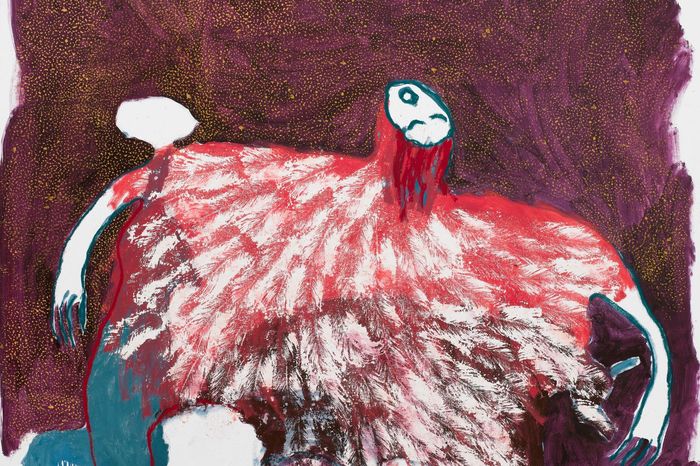Rasheed Araeen at Heong Gallery: art’s uniting force
Jen Price reviews the Heong Gallery’s new exhibition, exploring how multi-disciplinary work encourages innocence and play

The Heong Gallery’s recent exhibition, ‘Rasheed Araeen: A British Story’, poses questions about the very definitions of art. When viewing the exhibition, which is located in Downing College’s first court, my first thoughts were of the significance of this location as a home for the exhibit. The Heong Gallery is a small space, forcing the curators to be extremely selective in their assembling of the exhibition — this is evident in ‘A British Story’, which has chosen to focus on Araeen’s most overtly political works. But what is more important in terms of location is its position within an academic community of (mostly) young adults.
In a blurring of the lines between art and politics, this exhibition comments on a range of issues that expose racism and xenophobia within British society, including the death of David Oluwale in 1968. Although all people, regardless of age or location should be exposed to the significance of these problems, it is especially important that students at Cambridge, as they embark upon adulthood, have a well-rounded perspective of the issues that have shaped British society, both past and present.
“In this context, art acts as a uniting force”
That is not to say, however, that this exhibition will only be of interest to HSPS students — another aspect I found intriguing within the exhibition was the boundary between art and engineering. Araeen graduated from the NED University of Engineering and Technology in 1962, two years before his arrival in London, and his training is apparent in all of his works — most notable in pieces such as ‘First Structure’ (1966-67), which is striking due to its simplicity. In this structure, Araeen uses geometry, merging squares, triangles and straight lines, highlighting the role of engineering and physics within the creation of three-dimensional artwork. In another early work, ‘My First Sculpture’ (1959), these linear properties are challenged, as this sculpture is made of thin wire and contains no straight lines. Through this, one can see how the boundaries between engineering, technology and art have impacted Araeen’s work from the inception of his career. In this context, art acts as a uniting force — both arts and sciences students will be able to appreciate the craft involved in creating these works.

The traditional definitions of art and artwork are further explored through the exhibition’s use of both indoor and outdoor space. The Heong Gallery’s floor-to-ceiling windows provide visitors to the exhibition an opportunity to look across at Araeen’s works installed on the lawn behind the gallery. This merging of the interior and exterior works, in which the window acts as a screen for transition, questions the role of galleries like the Heong; ultimately, art cannot be confined to interior, organised spaces, but it must transcend these limits and be visible everywhere. This idea is reflected in works such as Araeen’s ‘Disco Sailing’. The exhibition contains a video of this performance from 2019, in Gorky Park Moscow. This ‘ballet on water’ is a reminder of the dynamic ideas of place in artwork — Araeen is unafraid to push the limitations of spaces in his work, in order to prioritise a personal engagement with the works. A unique element of ‘Disco Sailing’ is that the audience participates in the performance, blending art and sports.
“Neither political engagement nor youthful innocence exist in a vacuum”
The accessibility of art is further examined in this exhibition as the outdoor installations are not meant to simply be viewed, but can also be touched and moved — allowing the creation of art to become a collective effort. This exhibition is a refreshing reminder of the innocence of childhood, as we, the viewer, are encouraged to move the blocks of the artwork, much like children in a play area. Not only is Araeen’s art tangible, it forces students to reflect on the way that art unites generations. Our notion of what is accessible to whom is constantly being re-evaluated (in this instance through a large moveable sculpture, but also through Araeen’s references to political events which occurred 30 years before most Cambridge students were born).
The two principal elements of Araeen’s artworks — the political, and the innocent or childlike — may at first seem to be in opposition. Yet I find their combination to be the most inspiring aspect of ‘A British Story’. At its core, this exhibition serves as an important reminder that neither political engagement nor youthful innocence exist in a vacuum. In the modern world, it is easy to become desensitised to political violence, or to be ignorant about historical events, but it is only through appreciating the fundamental innocence and childlike spirit of human nature, that one can truly comprehend the severity of inhumane political violence, and act against it.
The Exhibition is at Downing’s Heong Gallery and is open 12PM to 5PM, Wednesday to Sunday until the 2nd of February 2025.
 News / Uni offers students £55k in payouts31 October 2025
News / Uni offers students £55k in payouts31 October 2025 News / Uni error forces deeper spending cuts31 October 2025
News / Uni error forces deeper spending cuts31 October 2025 News / College rowing captains narrowly vote to exclude trans women31 October 2025
News / College rowing captains narrowly vote to exclude trans women31 October 2025 News / Students launch women’s society excluding trans women31 October 2025
News / Students launch women’s society excluding trans women31 October 2025 News / Students allowed to use AI, says new uni guidance31 October 2025
News / Students allowed to use AI, says new uni guidance31 October 2025










